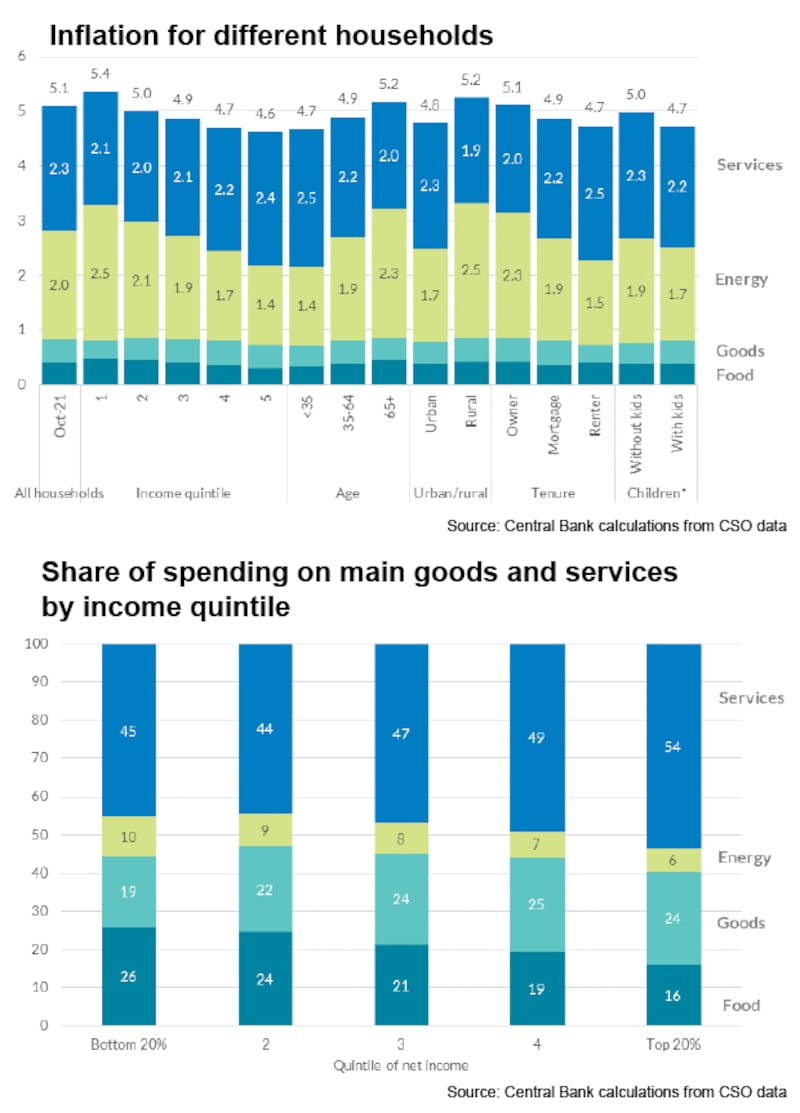Lower-income households, older people and those in rural areas are most exposed to the surge in inflation.
Central Bank research, based on spending patterns of different households from Central Statistics Office (CSO) data, shows that the proportion of household spending on energy and transport is the key issue in terms of where the burden of the current rise in prices is felt most heavily.
Houses at varying income levels typically have different spending patterns. Lower income households, with less cash to spare, typically concentrate their spending on essential goods – such as home heating, fuel for transport and food. Better-off households have more cash to spare and thus spend more on services – like eating out, for example, or holidays.

While higher-income households may spend more in cash terms on essentials, it is the proportion of spending in different areas which determines where the inflation burden hits hardest.
In a speech last year, Central Bank governor Gabriel Makhlouf pointed to CSO data from the 2015/16 Household Expenditure Survey (see graphic) which showed that the 20 per cent of households with the lowest income spent 10 per cent of their disposable income on energy, versus 6 per cent for the top 20 per cent.
More than one quarter of the income of the lowest 20 per cent went on food, compared to 16 per cent for the highest income group.
These spending patterns determine the impact of inflation on different households. The Central Bank’s analysis, based on the October annual inflation rate of 5.1 per cent, showed an inflation rate of 5.4 per cent for the lowest income households, compared to 4.7 per cent for the highest income group. The big difference was in the impact of home heating and fuel costs, which were much more significant for the lower income group.
Of course, lower income households also get hit harder for the simple reason that they have much less leeway in their weekly budgets. This is particularly the case for the very lowest income households, with ESRI research showing groups such as lone parents particularly at risk from rising fuel costs.
While the Central Bank analysis was based on October inflation data, the continued rise in fuel prices since then is likely to have widened the inflation gap between different households further. There are also increases in the prices of some staple foods more recently, such as breads and cereals, again essentials where prices rises hit lower earners hardest.
The bank also points out that over time spending can be affected by relative prices, which can change the arithmetic. The CSO started surveys in 2020 to update the spending survey.
As well as looking at income levels, the CSO also looked at other breakdowns. It found rural households faced an inflation rate of 5.2 per cent, versus 4.8 per cent for urban counterparts. Again a higher dependence on energy was the key factor, presumably influenced in part by greater reliance in rural areas on car transport.
Older people also face the pinch of inflation more, on average, than younger generations. While there is no further breakdown to explain this, it may be influenced by a lower income pensioner group as again energy spending is a key factor. While rents have risen sharply, the data also shows home owners facing a higher rate than those with a mortgage or renting. However, over a period of years soaring rents have clearly been a crunch issue for many households.
The key unknown now is how inflation will play out over the rest of the year and into 2023. The concern is that it could become embedded in people’s expectations, with businesses using the opportunity to pass on higher prices and wages rising in response. Already there are signs of it spreading to more goods and services. The outlook for energy prices, particularly gas, also remains hugely uncertain and expectations of a fall-back in energy costs as the year goes on are now open to question.
The longer duration of the inflationary surge is a key issue now for the Government and threatens to cause difficulties for lower-income households who may have used up much of their financial leeway already in the hope that the spike in fuel bills was temporary.












